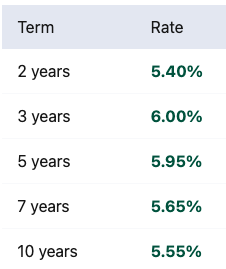©Annuity.org
1 S. Orange Avenue, Suite 200
Orlando, FL 32801
How To Use the Variable Annuity Calculator
You can use this variable annuity calculator to estimate your annuity’s future value simply by filling out the information required. You’ll provide details including your current age and tax rate, as well as the age and tax rate you’ll be at when you intend to start withdrawing from your annuity.
If you plan to continue contributing to your variable annuity throughout its term, you’ll enter into the calculator how much you expect to contribute each year. Additionally, you’ll tell the calculator the variable annuity’s starting balance and expected rate of return.
The calculator also considers how surrender charges could affect your annuity’s value.
If you’d like to factor in possible surrender charges, look up the variable annuity’s surrender charge schedule and enter the details into the calculator.
You’ll submit your variable annuity information by clicking the “Calculate” button. The calculator will then show you the expected value of your variable annuity when you begin withdrawals, assuming the average rate of return holds true.
This variable annuity calculator features a line graph that demonstrates how your annuity’s value could grow over the accumulation phase. The blue line represents your annuity’s value before taxes, while the green line represents the total amount of your annuity that is taxable income.
What Can a Variable Annuity Calculator Tell You?
The calculator can tell you an estimate of what your variable annuity could be worth when you reach retirement age and start withdrawals.
The calculator can also help you compare different variable annuity products. If you are looking at a few variable annuity options, you can plug in each product’s average rate of return and surrender charge schedule to see which annuity might be most beneficial for your financial plan.
How soon are you retiring?
What is your goal for purchasing an annuity?
Select all that apply
What Are Surrender Charges for Variable Annuities?
Insurance companies apply a surrender charge to a variable annuity contract if the annuity owner withdraws money early. The charge is expressed as a percentage of the amount withdrawn.
The surrender charge is usually imposed during the first several years of an annuity contract, and the percentage that is charged declines each year. A variable annuity might charge a 9% penalty on funds withdrawn in the first year, an 8% penalty in the second year, a 7% penalty in the third year and so on.
When shopping for a variable annuity, it’s important to consider the surrender charge schedule even if you don’t plan on withdrawing money from your annuity early. Financial emergencies can happen, and you may end up having to take some money out even if you didn’t plan to. So, you should always be aware of possible surrender charges before purchasing an annuity.
The calculator above can run estimates of a variable annuity’s value with or without surrender charges. You may want to input your annuity details into both options and compare the results to better understand how surrender charges can impact your annuity’s value.
Limitations and Considerations
This variable annuity calculator has some limitations resulting from the assumptions it must make to estimate the value of a variable annuity. For example, the calculator assumes that the annuity’s returns are compounded annually and that any contributions are made at the beginning of each year.
The biggest assumption the calculator makes is that your variable annuity will earn a consistent average rate of return. By design, variable annuities do not earn the same rate of return year after year; if they did, they would be fixed annuities.
Variable annuities change in value based on how the money in the annuity is invested. Because of this, the returns of a variable annuity are different each year; some years, the value of the annuity may even go down if market performance is poor.
This means that the future performance of a variable annuity can’t be predicted with certainty. The calculator above simply provides an estimate of the possible growth of a variable annuity if market conditions perform consistently.
The variable annuity calculator also does not factor in the various fees and expenses associated with variable annuities. This type of annuity has some of the most fees and expenses, including mortality and expense risk charges, surrender charges and subaccount management fees. These fees can total between 2.5% and 3% of the contract’s value.
A financial advisor can help you understand the benefits and drawbacks of variable annuities and decide whether this product is right for you. Consider speaking with a financial planning professional before purchasing a variable annuity.

Calculate Your Returns Based on Today’s Best Rates
Frequently Asked Questions
A variable annuity is an insurance product that accumulates value based on the performance of the portfolio that the annuity is invested in. When the annuity matures, the contract is converted into a lump-sum payout or stream of payments.
A variable annuity’s performance is affected by the equity market because variable annuities participate in the market. If the investments in a variable annuity underperform, the annuity’s value will decrease; if the investments do well, the annuity’s value will increase.
The pros of variable annuities include tax-deferred growth, initial investment protection and higher return potential than fixed annuities. The cons of variable annuities include high fees, complex contracts and the lack of a guaranteed return.
Investors between the ages of 50 to 55 are best suited to benefit from variable annuities because they have enough time to weather market downturns before the withdraw from the annuity in retirement.




